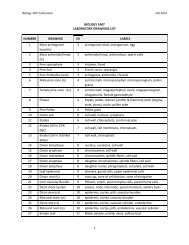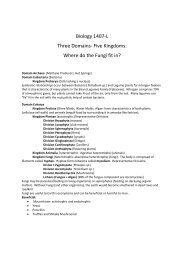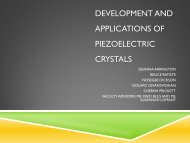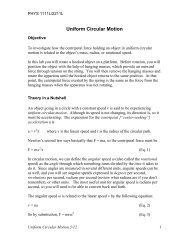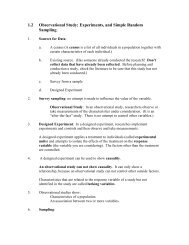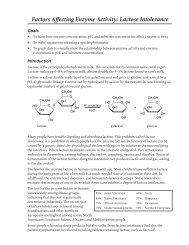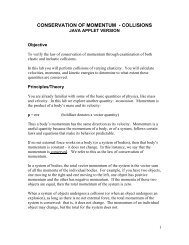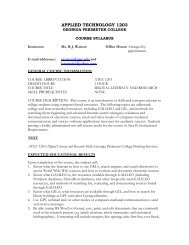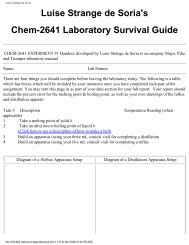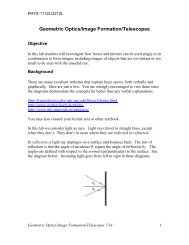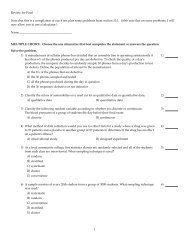Synthesis of Aspirin
Synthesis of Aspirin
Synthesis of Aspirin
You also want an ePaper? Increase the reach of your titles
YUMPU automatically turns print PDFs into web optimized ePapers that Google loves.
Experiment 19<br />
Preparation <strong>of</strong> <strong>Aspirin</strong><br />
Goals:<br />
Concept:<br />
1. Synthesize aspirin.<br />
2. Familiarize students with vacuum filtration and melting point<br />
techniques.<br />
3. Be able to calculate percent (%) yield <strong>of</strong> the synthesized product.<br />
4. Test the purity <strong>of</strong> the product.<br />
Acetylsalicylic acid is the chemical name for aspirin. It is a drug with<br />
many uses. It is used to reduce fever (antipyretic) and relieve pain and<br />
inflammation (analgesic). It contains an ester group and is synthesized by an<br />
esterification reaction. In this experiment, aspirin will be synthesized from<br />
salicylic acid and acetic anhydride using an acid, H2S04, as a catalyst. The<br />
reaction is shown below.<br />
~<br />
~O~OH +<br />
Salicylic acid<br />
(SA)<br />
R 0 H+<br />
CH3C-O-1b.CH3-<br />
Acetic anhydride<br />
o<br />
~<br />
II<br />
C-OH<br />
~CH3<br />
~<br />
Acety~alicylic acid<br />
ASA=aspiriin<br />
Calculation <strong>of</strong> possible theoretical yield from salicylic acid:<br />
o<br />
II<br />
+ CH3C-OH<br />
acetic acid<br />
vinegar acid<br />
mass (g) <strong>of</strong><br />
salicylic acid<br />
(SA)<br />
1 mole <strong>of</strong> SA<br />
1 mole <strong>of</strong> ASA 180 g ASA _ grams <strong>of</strong>asprin<br />
x<br />
x<br />
x - (ASA)<br />
138 g <strong>of</strong> SA<br />
1 mole <strong>of</strong> SA I moleASA<br />
possible product!<br />
(molecular weight) (molecular weight) theoretical yield/mass<br />
The purity <strong>of</strong> the aspirin will be determined by using two techniques,<br />
melting point, (a physical property) and the addition <strong>of</strong>FeCh, (a chemical<br />
property) for the un-reacted starting material, salicylic acid.<br />
Melting points are reported as ranges; temperature when the solid starts<br />
melting to the temperature it completely becomes liquid. Pure substances usually<br />
have narrow range (I-3°C) while impure substances have a wider melting range<br />
and the observed melting point is lower than that <strong>of</strong> the pure substance.<br />
The use <strong>of</strong> Ferric chloride, FeCh is also used to give a qualitative<br />
indication <strong>of</strong> the purity <strong>of</strong> the aspirin. The orange colored FeCh forms a purple<br />
color with a phenolic group (~OHdirectly attached to the benzene ring). Salicylic<br />
acid has a phenolic group while the product aspirin does not. Therefore, the<br />
formation <strong>of</strong> a purple complex with FeCh shows the presence <strong>of</strong> un-reacted<br />
salicylic acid.<br />
109
Materials:<br />
Salicylic acid, acetic anhydride, cone. H2S04,commercial aspirin,<br />
1 % FeC13,400mL beaker, hot plate, filter paper, watch glass, 125 mL<br />
Erlenmeyer flask, glass stirring rod, Buchner funnel, suction flask, rubber<br />
hose (vacuum hose), ice, melting point apparatus, mercury thermometer<br />
Wear safety goggles and do all parts <strong>of</strong> this experiment in the hood. Dispose <strong>of</strong><br />
chemicals in proper containers.<br />
Procedure:<br />
A. <strong>Synthesis</strong> <strong>of</strong> aspirin<br />
1. Set up a hot water bath using a 400-mL beaker half-filled with water on a<br />
hot plate as a source <strong>of</strong> heat. The water temperature in the beaker must be<br />
maintained at 100°C.<br />
2. Weigh a filter paper. Record the mass.<br />
3. Weigh a 125 mL Erlenmeyer flask. Record the mass.<br />
4. Add between 4.4 and 4.6 grams <strong>of</strong> salicylic acid (SA) to the flask and<br />
reweigh the flask containing the salicylic acid. Record the mass.<br />
5. Calculate the mass <strong>of</strong> the salicylic acid.<br />
6. Add 6 mL <strong>of</strong> acetic anhydride to the Erlenmeyer flask. Mix in the hood.<br />
Note: Acetic anhydride is an irritant to the nose and sinus. Be careful<br />
handling it.<br />
7. Slowly add (in the hood) 6-8 drops concentrated H2S04 to the flask,<br />
stirring the mixture with a glass stirring rod.<br />
8. Place the Erlenmeyer flask containing the mixture in the hot water bath.<br />
Continue to stir until the salicylic acid is completely dissolved.<br />
9. Remove the Erlenmeyer flask from the water bath and let it cool in cold<br />
water to room temperature.<br />
10. Add 20 mL <strong>of</strong> ice water (ice in distilled water). Place the flask in an ice<br />
bath, stir, and observe the formation <strong>of</strong> aspirin.<br />
11. Collect the crystals by vacuum filtration (refer to page 9B). First moisten<br />
the pre weighed filter paper with water and fit it in the Buchner funnel.<br />
Attach the funnel to the flask with a side arm. Attach one end <strong>of</strong> the<br />
vacuum hose to the side arm <strong>of</strong> the flask and the other end to the aspirator.<br />
110<br />
-- - - ---
12.<br />
Turn on the faucet and transfer the crystals from the Erlenmeyer flask to<br />
the funnel. Wash the crystals twice with 10mL <strong>of</strong> ice water each time.<br />
Continue the vacuum filtration until the crystals are dry. Carefully remove<br />
the filter paper from the funnel and place it in a watch glass in a secure<br />
place until next week.<br />
13. Weigh the filter paper with the crystals and calculate the actual mass<br />
(yield) <strong>of</strong> your synthesized aspirin.<br />
14. Calculate the theoretical yield and then the % yield <strong>of</strong> your aspirin.<br />
B. Test the product for purity:<br />
1. Meltini! point: Instructor, please show students how to use the melting point<br />
equipment. The melting <strong>of</strong> pure aspirin is 13SoC. Take the melting point <strong>of</strong><br />
your aspirin and compare it with that <strong>of</strong> a commercial aspirin.<br />
2. The use <strong>of</strong> FeCI}: Place a pinch (amount covering end <strong>of</strong>the microspatula) <strong>of</strong><br />
your prepared aspirin and crushed commercial aspirin in 2 separate test tubes.<br />
Add 5 drops <strong>of</strong>FeCb solution to each test tube. Compare the color <strong>of</strong>the two test<br />
tubes. The darker the purple color is, the more un-reacted salicylic acid is present<br />
in the aspirin.<br />
Data Table:<br />
Mass <strong>of</strong> filter paoer<br />
grams<br />
rams<br />
rams<br />
rams<br />
ams<br />
Theoretical yield (mass) <strong>of</strong> ASA, possible yield from<br />
stoichiometry (see calculation on the first page <strong>of</strong> lab)<br />
Actual yield (mass) <strong>of</strong> ASA from the exoeriment<br />
grams<br />
grams<br />
x 100 %<br />
Meltin<br />
Meltinl! ooint <strong>of</strong> commercial asoirin<br />
111
Questions:<br />
L<br />
1. A student used 3.50g <strong>of</strong> salicylic acid. Calculate the following:<br />
a) Theoretical yield (mass)<br />
b) The actual yield (from the experiment) was found to be 1.50<br />
grams less than the theoretical yield (mass), calculate the %<br />
yield.<br />
c) The melting point range <strong>of</strong> an unknown substance was<br />
determined to be 120o-12SoC.What can you tell about the<br />
purity <strong>of</strong> the unknown based on this information<br />
L<br />
2. <strong>Aspirin</strong> can irritate the stomach. What is added to the commercial<br />
aspirin to reduce its side effect.<br />
112



